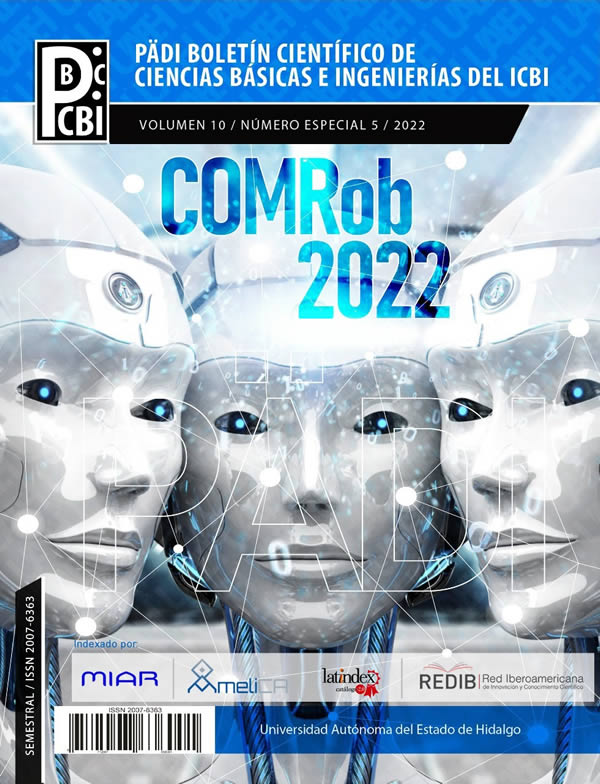Manipulating a robot arm by eye tracking
Abstract
Currently there is little literature and research related to Eye Tracking for the manipulation of robots or mechatronic devices. The articles that are available today are focused on the study of the human eye, especially medicine, marketing and gaming; however, there are few dedicated to the control or manipulation of technology (home automation, mobile robots: terrestrial, aerial or aquatic, robotic arms, mechatronic devices, among others). Therefore, this article focuses on the design and construction of a mechatronic device to record the eye tracking of the human being in order to manipulate a robot arm with three degrees of freedom; and the development of a friendly human-machine graphical interface to visualize the human eye and the commands for robot manipulation.
Downloads
References
Carelli, L.; Solca, F.; Tagini, S.; Torre, S.; Verde, F.; Ticozzi, N.;Ferrucci, R.; Pravettoni, G.; Aiello, E.N.; Silani, V. (2022). Gaze-ContingentEye-Tracking Training in Brain Disorders: A Systematic Review. Brain Sci. https://doi.org/10.3390/brainsci12070931
Poletti, B.; Carelli, L.; Solca, F.; Lafronza, A.; Pedroli, E.; Faini, A.; Zago, S.; Ticozzi, N.; Ciammola, A.; Morelli, C. (2017). An eye-tracking controlled neuropsychological battery for cognitive assessment in neurological diseases. Neurol. Sci. 38, 595–603.
Tao, L.;Wang, Q.; Liu, D.;Wang, J.; Zhu, Z.; Feng, L. (2020). Eye tracking metrics to screen and assess cognitive impairment in patients with neurological disorders. Neurol. Sci. 41. 1697–1704.
Syamimi Shamsuddin, Hanafiah Yussof, Luthffi Ismail, Fazah Akhtar Hanapiah, SalinaMohamed, Hanizah Ali Piah, and Nur Ismarrubie Zahari. (2012)Initial response of autistic children in human-robot interaction therapy with humanoid robot NAO. In Proceedings of the 2012 IEEE 8th International Colloquium on Signal Processing and Its Applications. 188–193.
Kerstin Fischer. Interpersonal variation in understanding robots as social actors. (2011). In Proceedings of the 6th International Conference on Human-Robot Interaction. ACM, 53–60.
Fumihide Tanaka and Shizuko Matsuzoe. (2012). Children teach a care-receiving robot to promote their learning: Field experiments in a classroom for vocabulary learning. Journal of Human-Robot Interaction.
Henny Admoni, Christopher Datsikas, and Brian Scassellati. (2014) Speech and gaze conflicts in collaborative human-robot interactions. In Proceedings of the 36th Annual Conference of the Cognitive Science Society (CogSci’14).
Chaoran Liu, Carlos T. Ishi, Hiroshi Ishiguro, and Norihiro Hagita.(2012). Generation of nodding, head tilting and eye gazing for human-robot dialogue interaction. In Proceeding of the 2012 7th ACM/IEEE International Conference Human-Robot Interaction (HRI). IEEE, 285–292.
B. Mutlu, T. Shiwa, T. Kanda, H. Ishiguro, and N. Hagita. (2009) Footing in human-robot conversations: How robots might shape participant roles using gaze cues. In Proceedings of the 4th ACM/IEEE International Conference on Human Robot Interaction. ACM, 61–68.
Rich, Charles, Brett Ponsler, Aaron Holroyd, and Candace L. Sidner. (2010). Recognizing engagement in human-robot interaction. In Proceedings of the 2010 5th ACM/IEEE International Conference on Human-Robot Interaction (HRI). IEEE, 375–382.Staudte , Maria Staudte andMatthew
W. Crocker. (2011). Investigating joint attention mechanisms through spoken human–robot interaction. Cognition 120, 2 (2011), 268–291.
Tanaka, Y.; Kanari, K.; Sato, M. (2021). Interaction with virtual objects through eye-tracking. Int. Workshop Adv. Image Technol. 2021.
Fuchs, S.; Belardinelli, A. Gaze-Based. (2021). Intention Estimation for Shared Autonomy in Pick-and-Place Tasks. Front. Neurorobotics 2021. 2021.
Bai, K.;Wang, J.;Wang, (2020). H. Study on Fixation Effect of Human Eye to Calibration Interface. Trans. Beijing Inst. Technol. 2020.1195–1202.
Eid, M.A.; Giakoumidis, N.; El Saddik, A. (2016). A Novel Eye-Gaze-Controlled Wheelchair System for Navigating Unknown Environments: Case Study with a Person with ALS. IEEE- 4, 558–573.
Al-Rahayfeh, A.; Faezipour, M. (2013). Eye Tracking and Head Movement Detection: A State-of-Art Survey. IEEE J. Transl. Eng. Health Med. 2013.
Voznenko, T.I.; Chepin, E.V.; Urvanov, G.A. (2017). The Control System Based on Extended BCI for a Robotic Wheelchair. In Proceedings of the 8th Annual International Conference on Biologically Inspired Cognitive Architectures, BICA, Moscow, Russia, 1–5.
Hua, B.; Hossain, D.; Capi, G.; Jindai, M. (2016). Yoshida, I. Human-like Artificial Intelligent Wheelchair Robot Navigated by Multi-Sensor Models in Indoor Environments and Error Analysis. In Proceedings of the 2016 IEEE International Symposium on Robotics and Intelligent Sensors, IRIS, Tokyo, Japan, 17–20.
Chatterjee, S.; Roy, S. (2021). A low-cost assistive wheelchair for handicapped & elderly people. Ain Shams Eng. J., 12, 3835–3841.
Cojocaru, D.; Manta, L.F.; Vladu, I.C.; Dragomir, A.; Mariniuc, A.M. (2019). Using an Eye Gaze New Combined Approach to Control a Wheelchair Movement. In Proceedings of the 23rd International Conference on System Theory, Control and Computing (ICSTCC). Sinaia, Romania, 9–11
Cojocaru, D.; Manta, L.F.; Pan˘a, C.F.; Dragomir, A.; Mariniuc, A.M.; Vladu, I.C. (2022). The Design of an Intelligent Robotic Wheelchair Supporting People with Special Needs, Including for Their Visual System. Healthcare. https://doi.org/10.3390/healthcare10010013
Poole, A. and Ball, L. J. (2016). Eye tracking in HCI and usability research. Encyclopedia of human computer interaction. 211-219.
Duchowski- (2017). A. Eye tracking methodology: Theory and practice.
Tobii (2022). https://www.tobiipro.com/product-listing/tobii-pro-glasses-3/
Martinez-Marquez, D.; Pingali, S.; Panuwatwanich, K.; Stewart, R.A.; Mohamed, S. (2021). Application of Eye Tracking Technology in Aviation, Maritime, and Construction Industries: A Systematic Review. Sensors.
Xu, B.; Li,W.; Liu, D.; Zhang, K.; Miao, M.; Xu, G.; Song, (2022). A. Continuous Hybrid BCI Control for Robotic Arm Using Noninvasive Electroencephalogram, Computer Vision, and Eye Tracking. Mathematics 2022, 10, 618. https://doi.org/10.3390/math10040618.
Scalera, L.; Seriani, S.; Gallina, P.; Lentini, M. (2021) Gasparetto, A.Human–Robot Interaction through Eye Tracking for Artistic Drawing. Robotics, 10, 54. https://doi.org/10.3390/robotics10020054













